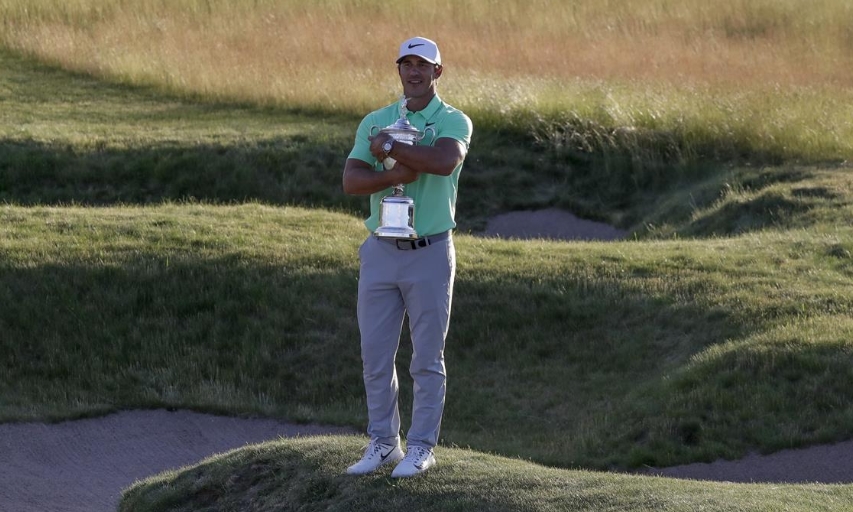Low Scores At Erin Hills Has Traditionalists Seeing Red
- Details
- Category: Inside Golf
- Published: 2017-06-21

Brooks Koepka Poses With The Winning Trophy After The U.S. Open. (AP Photo/Chris Carlson)
ERIN, Wisconsin (Doug Ferguson/AP) — Brooks Koepka is a modern golfer who won his first major on a modern golf course.
That would be one way to look back at this U.S. Open.
No one played better. No one did a better job of answering every challenge. He putted for birdie on every hole except the 13th, where Koepka made a clutch par putt that sent him toward three straight birdies, a knockout punch. That 8-iron he hit to the back portion of the 15th green was better than it could ever look on TV.
But as Koepka posed with the U.S. Open trophy on the 18th green, it was hard to ignore the white scoreboard behind him.
All the numbers were red.
The only black on the board through 18 holes were the names.
One of them belonged to Xander Schauffele, a 23-year-old rookie on the PGA Tour who was No. 352 in the world and playing in his first major championship. He finished at 10-under par. Great playing. Schauffele was among seven players who finished at 10 under or better.
Before last week, only two players in U.S. Open history had ever finished at double digits under par. One was Tiger Woods. The other was Rory McIlroy.
Is that bad? Not necessarily.
Two years ago, the PGA Championship at Whistling Straits and the British Open at St. Andrews each had more players finish under par.
But they aren't the U.S. Open.
This didn't look like one, either.
Maybe that's what Jack Nicklaus was thinking a few weeks before the U.S. Open on a course he had never seen — Erin Hills opened only 11 years ago — when he said, "I think the USGA has gotten away from their identity."
Erin Hills was never meant to resemble Oakmont or Winged Foot or any of the traditional golf courses with thick rough framing narrow fairways. Nicklaus knows that. He just felt the U.S. Open was different from the other majors. This one was hard to distinguish from a PGA Tour event.
"Why do you want to be like every other tournament?" Nicklaus said. "I guess I'm old-fashioned, but I like having to drive the ball straight, which was not really my strong suit all the time. I forced myself to take 3-wood or 1-iron to keep the ball in the fairway. The whole U.S. Open was about discipline. They're changing it every year."
There's an argument to give Erin Hills another chance.
Had the wind blown all week the way it did on Sunday, it would have presented a stronger test and struck a little more fear into the players over certain shots. Had it blown all week the way it did Sunday morning — the strongest gusts since 1992 at Pebble Beach — there would have been more complaints.
That's the identity of the U.S. Open.
When no one complains at a U.S. Open, something must be wrong. Even players who missed the cut went quietly, and with compliments.
Not that the USGA would complain about that this year. It needed a quiet week after the rules mess at Oakmont and the putting surfaces at Chambers Bay, two U.S. Opens saved by the quality of the winners, Dustin Johnson and Jordan Spieth.
What dulled this U.S. Open was rain that kept the fairways from getting firm, and thus allowed for even wider landing areas; and the lack of strong wind. If the USGA had tightened fairways and made the greens brick-hard, typically strong wind would have turned this into carnival golf.
No one wants that, either.
The weakness of Erin Hills was that it depended solely on the wind to be the test the U.S. Open deserves. Justin Thomas said as much after his 63, only the fifth such score at a U.S. Open, the first in 14 years and the only one on a par 72.
"It doesn't matter how long, how whatever the course is," Thomas said of the 7,741-yard course, the longest of any major. "When you give us soft greens, good greens and not much wind, you know there are going to be some good scores. I was just happy that I was the one that was able to take advantage."
And that's what Koepka did. That's why he's a deserving U.S. Open champion. No matter how good the scoring was, his was the lowest.
Is it worth coming back?
Maybe after a steady diet of Shinnecock Hills, Pebble Beach, Winged Foot, Oakmont and other traditional venues, golf fans will be clamoring for it. But the identity of the U.S. Open is the one tournament each year where players struggle to make par.
That was lost this year.
Along with crowning a worthy U.S. Open champion, the USGA at least went a long way toward convincing skeptics that it doesn't care about protecting par.
But if it doesn't come back to Erin Hills, what will that say about it?



